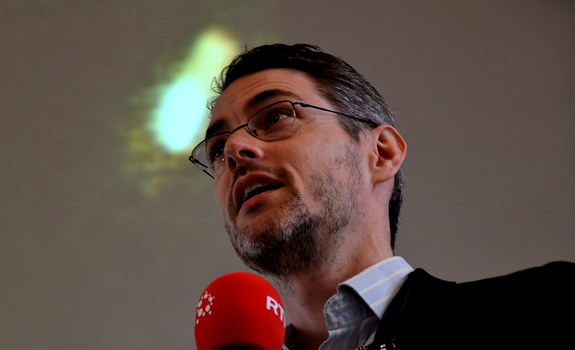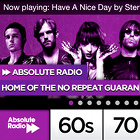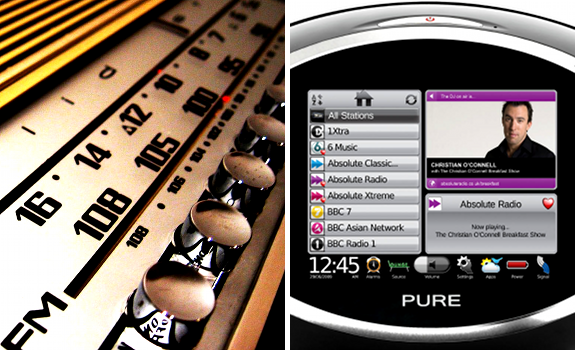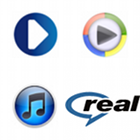Young listeners still tune in to radio, but they’re listening for less and less time! How to keep radio relevant for young people in a multi-platform world?
Radio futurologist and world traveler James Cridland offered some answers during the Atelier Radiophonique Romand 2013 conference in Switzerland. Why building communities and being relevant matters more than promoting The #1 Hit Music Station and discussing DAB, plus ideas on how to make radio visual and user-friendly for young listeners.
“Apart from the crazy Dutch,
radio is listened to less by younger audiences”

Based on a comparison between 2006 and 2010, both the Netherlands and Flanders show the least increase (-2%) in Time Spent Listening of most European radio markets, based on all age demographics together (chart: EBU)
Keep young listeners engaged
“Apart from the crazy Dutch, radio is listened to less by younger audiences”, James Cridland says in reference to Time Spent Listening trends in European radio markets. [Flanders is doing equally well; the public broadcaster VRT has a policy to turn radio stations into 360° brands to reach a new generation.] “Some radio broadcasters say that […] as younger audiences get older, they consume more radio. But the figures that we are seeing now […] say that radio has less of a place in younger audience’s hearts, and that radio isn’t recovering as that generation gets older.” He offers several ways to reach young radio listeners in a multi-platform world.
 Broadcast multi-platform content
Broadcast multi-platform content
“We spend hours and hours; days and days arguing on forums and other places about what radio platform is best”, Cridland says about the enless discussion around FM, DAB, DAB+, the Internet and so on. His advice is to “don’t waste your time on which platform is the future, because the answer is: all of them. Radio’s future is a multi-platform future. The right platform, for the right person, right now.”
Be where listeners are
In the UK, less than 2/3rd (62.6%) of all radio listening is happening on AM and FM, based on RAJAR data from January 2013. “Radio audiences are moving away to other platforms”, is the radio futurologist’s conclusion. The 3 most-used digital alternatives for analogue radio in the UK are the following:
• TV – Digital radio channels on television
• DAB – Terrestrial digital audio broadcasting
• Internet – Online simulcast of a radio station’s main signal (and additional channels)
Cridland considers Digital Audio Broadcasting (the most popular of the above) to be “very good in terms of adding additional choice” and sees that it’s quickly becoming the standard. “It’s impossible now to buy a radio in the UK without DAB, and a third of all new cars have DAB fitted.” An interesting phenomenon is that different audience demographics prefer different digital platforms: while BBC Radio 6music is mostly listened-to on DAB, digital television is the most popular way of tuning into BBC Radio 1Xtra.
“There are still a few radio presenters
who really know their music, but things like
Powergold and Selector have kind of stopped that”

BBC Radio 1Xtra morning jock Twin B (left) has most of his young listeners tune in through digital TV, while the majority of Shaun Keaveny’s breakfast show audience on BBC Radio 6music listens through DAB (photos: BBC)
Add brand-extending channels
All over the world, new platforms create new opportunities for radio, for example:
• Australian radio brands are using a lot of what DAB and online have to offer, such as temporary radio stations for special events – from the Melbourne Arts Festival to a Pink concert tour. These could be great ways to earn more advertising revenue as well.
• British radio stations are adding additional brand experiences. Smooth Radio has two separate channels to help its brand grow: Smooth 70s, which plays music from the 40+ audience’s favorite decade, and Smooth Christmas during November and December.
 Establish USP-based positioning
Establish USP-based positioning
James Cridland makes clear that unlike 30 years ago, radio doesn’t own the music monopoly anymore. “If I want to hear brand new songs of my favorite artists, I can just look at their YouTube page for free. Artists can send me an email whenever they release anything – and if I want to find out what Lady Gaga is doing, I can just follow her on Twitter and I’ll be connected to her brain 24 hours a day; learning what she’s thinking…”
Promote more than music
His impression is that while YouTube is the main source for young people to find new music, many stations – even those for young audiences – rely more and more on play-out systems and automation: “Instead of YouTube, which gives me a ton of additional choice, we end up playing non-stop music. We promote ourselves sometimes exclusively on our music proposition: Today’s Best Music Mix, The #1 Hit Music Station, More Music Variety and ‘10 songs in a row’. I’m sure we’re still close to artists and record companies, and there are still a few radio presenters who really know their music, but things like Powergold and Selector have kind of stopped that.”
“Communities are at the heart of what we do”

James Cridland thinks that radio should focus on (facilitating the) sharing of mutual experiences (photo: ARARO)
Focus on human connection
In Cridland’s opinion, users of YouTube, Pandora, Spotify, AUPEO! [didn’t know that one yet] and similar services actually get a better / more relevant choice of music, that is just for them. “And they get the ‘skip’ button; something that radio can’t offer, yet is actually a really good feature that the Internet gives you.” His rhetorical question is whether radio’s future really is about being famous for playing music – “slightly worse; without a skip button” – or if our mission is to connect people through radio.
 Build a strong community
Build a strong community
“Communities are at the heart of what we do”, he says, clarifying that such a group of people can be based on living in the same area, but also on sharing a mutual interest. “Live radio can offer communities a shared experience. I’m not talking about airy-fairy public service broadcasting that nobody listens to in terms of getting close to your community. I’m talking about things which are exciting for audiences, and from an advertising point of view as well.”
Increase your audience feedback
As an example, Cridland shows the often-mentioned, but relevant example of 102.3 NOW! Radio in Edmonton, Canada [also featured in: Social Media Run The Radio Show]. The station is basically a social network on the radio and continuously invites listeners to Join the Conversation – both on air and off air. It made them number 1 in the market. “They concentrate not just on getting their music mix right, but also on getting their audience involved. They reply to every single tweet, every single Facebook message and every text message. In the first year, they sent 1 million text messages and replied to every single one of those by hand. How many of us ask for people to get in contact, and never bother replying?”
“They’ve turned that 2-hour show
into a 24-hour brand”

TOKYO FM is extending radio broadcast content through online social communities (photo: Friendly Planet Travel)
Build brands around shows
Communities are also important for TOKYO FM, the number 1 privately held radio station in Japan’s main city. The FM band there is remarkably different from many others in the world, starting at 76 MHz and going all the way up to 108. TOKYO FM is broadcasting on 80.0 FM (referred to on-air as “eighty point love”) and has a humoristic music show in the evening called School of Lock (instead of Rock). They extend radio content through mobile apps and websites. “They’ve turned that 2-hour show into a 24-hour brand by really building a community around that.”
 Offer relevant programming & advertising
Offer relevant programming & advertising
As radio works when it’s both very close and very relevant, James Cridland pleads that radio broadcasters should more often use and monetize specific audience targeting, which might actually service the listener. “When people are listening to us on the Internet, we automatically know where they are and what kind of device they’re connected to. Advertising is only annoying when it’s irrelevant – if it’s relevant, it’s great content.”
Sell narrow-targeted spots & ads
He mentions the Absolute Radio platform as an example. “You’re invited to register online and as a result, you’ll get a better quality signal and less advertising, but more importantly: advertising which is targeted to you. They sell targeted advertising at a significant premium: sometimes 10 times of what they get from normal advertising. Secondly, the audience appears to like it.” From all the major radio brands in the UK, Absolute Radio has the largest amount of people tuning in to them online. “They’ve recently posted the highest audience for that brand in the last 11 years.”
“If radio’s future is a multi-platform future,
radio needs a multi-platform interface as well”

Radio receivers are moving from the classic analog interface to a modern digital application, which offers a more user-friendly radio listening experience, and provides additional information (photos: everystockphoto / PURE)
Develop user-friendly radio experience
James Cridland underlines the importance of a more intuitive user experience to attract younger audiences. “We in the radio industry seem not to care that we’re giving our audience a really poor user experience”, is his critical note. “A mobile phone offers amazing graphics on a color screen. But when you use that to tune into FM radio, you [often] get a really tedious and boring experience.” Cridland thinks that radio can learn from the television industry, as TV companies usually offer “clear and straightforward” intuitive user interfaces.
 Produce multi-platform radio receivers
Produce multi-platform radio receivers
“If radio’s future is a multi-platform future, radio needs a multi-platform interface as well”, Cridland says. He’s demonstrating a RadioDNS-based hybrid radio that receives audio from a variety of sources. To tune in, users only need the station’s name; not its frequency. In case a station is locally not available on FM or DAB, the smart receiver will automatically look for the right channel on the Internet. The tuner can show extra information as well.
Visualize your audio stream
In James Cridland’s opinion, “we need to think about how radio will look, as well as sound”. RTL 102.5 in Italy has been taking visual radio to the next level – their radio studio is set up like a television set. Jingles and beds for certain show bits are being visualized as well, and when a song plays on the radio, its music video is being shown on the screen. The Radiovisione web player allows users to flip between a ‘normal’ text & image enhanced audio stream, and the complete visual radio experience. In the UK, BBC Radio 1 has recently begun visualizing the weekly chart show. “A much more interesting experience for younger audiences, for [which] music has always been a visual experience.”
“We really help our industry if we talk together as one”

Capital FM is using popular artists in their TV ads to promote radio in general, too – click to play (image: YouTube)
Innovate radio across industry
“That’s a tremendous TV ad. Firstly, it’s got lots of stars in it, but secondly: they’re all talking about how great radio is. That’s really good as a step forward”, Cridland says about the Capital FM commercial. “We really help our industry if we talk together as one [earlier presentation]. If we all speak about the benefits of radio; not just those of our own station, then all of radio will benefit. Our listeners and advertisers are now not just thinking about one radio station over another. They’re thinking about radio over Spotify; radio over YouTube.”
 Choose one play-out standard
Choose one play-out standard
James Cridland says that an industry-wide collaboration is also a matter of not re-inventing the wheel again. He thinks it’s “pointless” that many stations use different technologies to play audio streams on their sites. “Frankly, when you’re listening to radio over the Internet, it’s really a nasty; horrible; jumbled up experience. Different players are working in different ways. Some people use Windows Media Player; some use Real Player – whatever that was…”
Surpass UK Radioplayer’s success
The British radio industry mutually gave birth to the Radioplayer, a universal interface for streaming radio online. As of February 2013, almost 350 radio stations in the UK are using it. While every station customizes the framework with their own logo and colors, all functionality ‘under the hood’ remains the same. “The figures say that in Radioplayer’s first full year, radio listening over the Internet increased by 37%. So if we act as one radio industry, we’re in a better place to attract all audiences – young and old.” Cridland concludes by saying that “this will make our advertisers and those who work for us smile, and most importantly: it will make our audience smile as well.”





Hi Beau,
Glad you enjoyed the article!
In most European countries, radio is still reaching many people – but especially young ones are listening for a shorter amount of time (probably because they spend more time online).
The data are based on a EBU member data from 2010, and are mentioned in several different presentations about the future of radio. One of them is Belgian public broadcasting radio director Els van de Sijpe’s talk about VRT and the Youth at the ARARO conference in Switzerland in 2013.
My personal expectation is that radio will always be here – and that new media and digital distribution will enable us to add value. From additional channels to visual content and (even more) social interaction (than good radio already provides today).
Cheers,
Thomas
Thank you very much for your contribution, Thomas. Thoughtful piece.
Would you mind providing the source to the declining listening time data?
I think many people – including those from a young generation – still love to switch on Capital and get the hits.
Just push 1 button and get those 10 songs in a row, that’s instant gratification.
Taylor